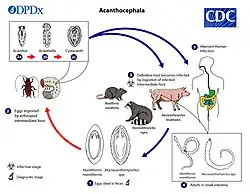Intraproboscis
Intraproboscis is a monotypic genus of acanthocephalans (thorny-headed or spiny-headed parasitic worms) that infest African black-bellied pangolin in the Central African Republic. Its body consists of a proboscis armed with hooks which it uses to pierce and hold the gut wall of its host, and a long trunk. It contains a single species, Intraproboscis sanghae. This genus resembles species in the genus Mediorhynchus but is characterized by infesting a mammal instead of birds, and having a simple proboscis receptacle that is completely suspended within the proboscis, the passage of the retractor muscles through the receptacle into the body cavity posteriorly, absence of neck, presence of a parareceptacle structure, and a uterine vesicle. The proboscis is armed with 34–36 rows of 6 to 7 hooks anteriorly and 15–17 spinelike hooks posteriorly which are used to attach themselves to the intestines of the host. The female worms are up to 180 millimetres long, virtually all of which is the trunk, and 2 millimetres wide.
| Intraproboscis | |
|---|---|
| Scientific classification | |
| Domain: | Eukaryota |
| Kingdom: | Animalia |
| Phylum: | Acanthocephala |
| Class: | Archiacanthocephala |
| Order: | Gigantorhynchida |
| Family: | Giganthorhynchidae |
| Genus: | Intraproboscis Amin, Heckmann, Sist, and Basso 2021 |
| Species: | I. sanghae |
| Binomial name | |
| Intraproboscis sanghae Amin, Heckmann, Sist, and Basso 2021 | |
Taxonomy
Intraproboscis is a genus of acanthocephalans which are thorny-headed or spiny-headed parasitic worms. The genus name describes the unusual position of the receptacle within the proboscis and the species name denotes the tribal name in the specific geographical location where the specimens were collected in the Central African Republic.
| Archiacanthocephala | |||||||||||||||||||||||||||||||||||||||
| |||||||||||||||||||||||||||||||||||||||
| Phylogenetic reconstruction for select species in the class Archiacanthocephala based on a 28S rRNA gene comparison from Gomes et. al (2019) and a 18S rDNA gene comparison from Amin et al. (2020).[1][2] |
Description
| Measurements | Female (mm) |
|---|---|
| Length of proboscis | |
| Width of proboscis | |
| Length of proboscis receptacle | |
| Width of proboscis receptacle | |
| Length of neck | |
| Width of neck at base | |
| Length of trunk | |
| Width of trunk | |
| Length of lemnisci | |
| Size of anterior testis | |
| Size of posterior testis | |
| Size of cement glands | |
| Size of Saefftigen's pouch | |
| Size of eggs | |
| Distance from the uterine bell to genital pore | |
Distribution
The distribution of I. sanghae is determined by that of its hosts. I. sanghae has been found in the Central African Republic.
Hosts

.jpg.webp)
The life cycle of an acanthocephalan comprises three stages beginning when an infective acanthor (development of an egg) is released from the intestines of the definitive host and then ingested by an arthropod, the intermediate host. Although the intermediate hosts of Intraproboscis are not known, however pangolins eat many insects. When the acanthor molts, the second stage called the acanthella begins. This stage involves penetrating the wall of the mesenteron or the intestine of the intermediate host and growing. The final stage is the infective cystacanth which is the larval or juvenile state of an Acanthocephalan, differing from the adult only in size and stage of sexual development. The cystacanths within the intermediate hosts are consumed by the definitive host, usually attaching to the walls of the intestines, and as adults they reproduce sexually in the intestines. The acanthor are passed in the feces of the definitive host and the cycle repeats. There are no known paratenic hosts (hosts where parasites infest but do not undergo larval development or sexual reproduction) for Intraproboscis.[4]
I. sanghae parasitizes the pangolin by infests these hosts by using hooks on their proboscis to pierce and hold the wall of the intestines.
Notes
References
- Nascimento Gomes, Ana Paula; Cesário, Clarice Silva; Olifiers, Natalie; de Cassia Bianchi, Rita; Maldonado, Arnaldo; Vilela, Roberto do Val (December 2019). "New morphological and genetic data of Gigantorhynchus echinodiscus (Diesing, 1851) (Acanthocephala: Archiacanthocephala) in the giant anteater Myrmecophaga tridactyla Linnaeus, 1758 (Pilosa: Myrmecophagidae)". International Journal for Parasitology: Parasites and Wildlife. 10: 281–288. doi:10.1016/j.ijppaw.2019.09.008. PMC 6906829. PMID 31867208.
- Amin, O.M.; Sharifdini, M.; Heckmann, R.A.; Zarean, M. (2020). "New perspectives on Nephridiacanthus major (Acanthocephala: Oligacanthorhynchidae) collected from hedgehogs in Iran". Journal of Helminthology. 94: e133. doi:10.1017/S0022149X20000073. PMID 32114988. S2CID 211725160.
- CDC’s Division of Parasitic Diseases and Malaria (11 April 2019). "Acanthocephaliasis". www.cdc.gov. Center for Disease Control. Retrieved 17 July 2023.
- Schmidt, G.D. (1985). "Development and life cycles". In Crompton, D.W.T.; Nickol, B.B. (eds.). Biology of the Acanthocephala (PDF). Cambridge: Cambridge Univ. Press. pp. 273–305.